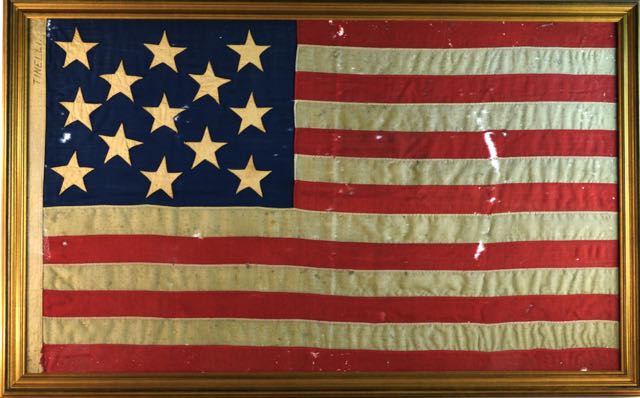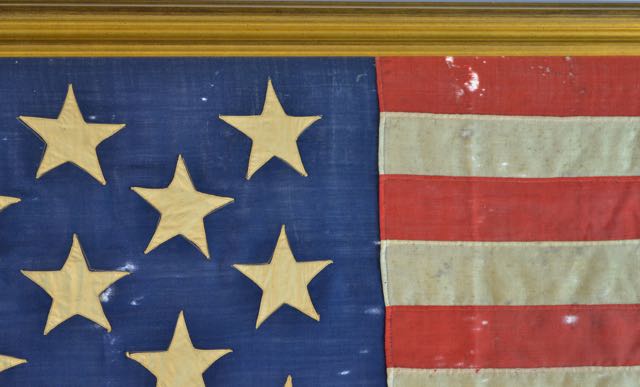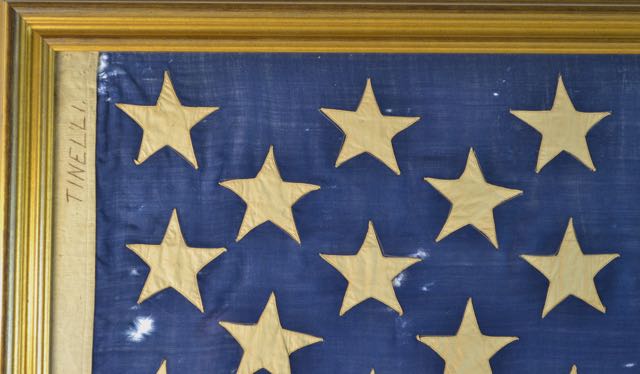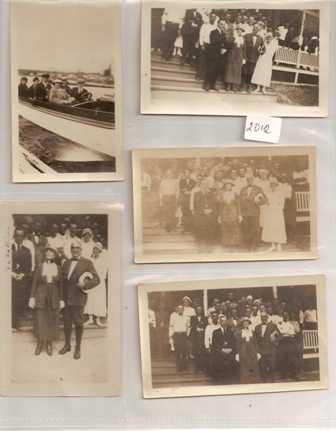Description
ID’ed Hand Sewn 13 Star Civil War Flag (On hold)
Rare opportunity to own a authentic antique hand sewn Civil War Flag and to know the owner. Antique 13 Star Flags are quite rare from this time period and if you find one most were naval flags called Ensigns. Its more rare to find a 13 Star that was used by the Army as is in this case. The flag has a name printed on the hoist in bold period ink, “TINELLI” This is a fairly rare name. It is identified to Louis W. Tinelli He enlisted into the Army on 12-6-1861 in New York City and was commissioned as a Lieutenant Colonel. This fact make it clear that he was a highly educated and affluent member of society as many high ranking positions were given based on your social status and not military experience. It is also clear that this flag is made so well it appears to be made by a professional Taylor. Judging that the Colonel was affluent he commissioned a hand made flag for his personal and Company use. The flag is also very unusual that it is a very small size, this also give us a clear understanding of the Colonels use of the flag, as his personal Guidon Flag which on a staff would be posted outside his tent. He was commissioned into Field & Staff NY 90th Infantry. He was discharged for a disability on 5-31-1863
This flag is a work of art and would have been very expensive in its day. Only a wealthy person could have commissioned its making. It will be a compliment to any historical or Civil War collection.
The flag is made of fine wool and has double applicae stars made of fine linen with impeccable tiny hand stitching. The hoist is a heavy weight lined. There is wear and tear in areas of the flag and shows signs of use.
Museum framing with UV acrylic
The following is the History of the 90th NY
90th Infantry Regiment
Civil War
Hancock Guard; McClellan Chasseurs; McClellan Rifles
History
Mustered in: September to December 1861
Mustered out: February 9, 1866
The following is taken from New York in the War of the Rebellion, 3rd ed. Frederick Phisterer. Albany: J. B. Lyon Company, 1912.
The Hancock Guards, recruited by Col. Louis W. Tinelli, under authority from the War Department, dated August 19, 1861, were consolidated with the McClellan Rifles, recruited ” by Col. J. S. DeAgreda, with L. W. Tinelli, as Colonel. Company C of the McClellan Rifles was formed of the British Volunteers, recruited by Col. R. E. A. Hampson. The Secretary of War granted authority to Lieut-Col. Robert B. Clark, 13th Militia, to recruit a regiment; this authority was later transferred to Col. Joseph S. Morgan, who under it recruited the McClellan Chasseurs. The State authorities organized the 90th Regiment at New York city November 20, 1861, by the consolidation of these two incomplete organizations, with J. S. Morgan as Colonel, L. W. Tinelli as Lieutenant Colonel, and J. S. DeAgreda as Major. The McClellan Rifles formed Companies A to E, and the McClellan Chasseurs F to K. The regiment was mustered in the service of the United States for three years between September and December, 1861. April 6, 1863, Companies H and I, and in fall, 1864, Company B, were consolidated with the other companies. At the expiration of its term of enlistment the men entitled thereto were discharged, December 10, 15 and 17, 1864, at New York city, and the regiment, which had returned from its veteran furlough in September, 1864, with new Companies B, H and I, mustered in for one year, was retained in service, but, November 28, 1864, consolidated into a battalion of six companies, A, B, C, D, E and F. June 3, 1865, it received, by transfer, the men of the 114th, 116th and 133d Infantry, not mustered out with their respective regiments.
The companies were recruited principally: A, B and C at New York city; D at Clyde; E at Unadilla, Nineveh and Otego; F, I and K at Brooklyn, East New York and Long Island; G at Brooklyn and New York city; H at Brooklyn, Dunkirk and New York city; the second Companies B at Norwich; H in Chautauqua county; and I at Medina, Ridgway and Shelby.
The regiment left the State January 5, 1862; served at Key West, Fla., and in the Department of the South, and unassigned in 10th Corps, from January, 1862; in 19th Corps, from April, 1863; in 1st Brigade, 4th Division, 19th Corps, from May, 1863; in 2d Brigade, 2d Division, 19th Corps, from February, 1864; in the 1st Brigade, 1st Division, 19th Corps, from March, 1864; the nonveterans, while the regiment was on veteran furlough, with the 160th N. Y. Volunteers in August and September, 1864; the regiment in the Army of the Shenandoah from October, 1864; in 1st Brigade, Dwight’s Division, Washington, D. C., from April, 1865; in same brigade and division, Department of the South, at Savannah, Ga., from June, 1865; in 3d Brigade, 1st Division, Department of Georgia, at Hawkinsville, Ga., from July, 1865; and at Savannah, Ga., in January, 1866, where it was honorably discharged and mustered out, under Col. Nelson Shaurman, February 9, 1866.
During its service the regiment lost by death, killed in action, 2 officers, 33 enlisted men; of wounds received in action, 25 enlisted men; of disease and other causes, 8 officers, 183 enlisted men; total, 10 officers, 241 enlisted men; aggregate, 251; of whom 14 enlisted men died in the hands of the enemy.
The following is taken from The Union army: a history of military affairs in the loyal states, 1861-65 — records of the regiments in the Union army — cyclopedia of battles — memoirs of commanders and soldiers. Madison, WI: Federal Pub. Co., 1908. volume II.
Ninetieth Infantry.—Cols., Joseph S. Morgan, Nelson Shaurman; Lieut.-Cols., Lewis W Tinelli, Nelson Shaurman, John C. Smart, Henry De La Paturelle; Majs., Joseph S. D. Agreda, Nelson Shaur-man, John C. Swart, Henry De La Paturelle. This regiment, known as the Hancock Guard, was recruited mainly in New York city and vicinity and was mustered into the U. S. service at New York from Sept. to Dec., 1861, for a three years’ term. It embarked on Jan. 5, 1862, for Key West, Fla., where it performed garrison duty for some months. Early in 1863 it was ordered to join the 19th corps in Louisiana and was assigned to the 1st brigade, 4th division. From New Orleans the regiment moved to Port Hudson, where it took an active part in the siege, losing 50 killed, wounded or missing. It was also closely engaged at Bayou La Four.che, with the loss of 71, and in March, 1864, shared in the Red River campaign. The reenlisted men received their veteran furlough in Aug. and Sept., 1864, and the remainder of the regiment served in their absence with the 160th N. Y. infantry. The veteran regiment was ordered to Virginia early in September and joined the Army of the Shenandoah while it was conducting the campaign against Gen. Early. The 90th fought at the Opequan, Fisher’s hill and Cedar creek, losing 73 in killed, wounded and missing in the last named engagement. The original members not reenlisted were mustered out during Dec., 1864, and the regiment was consolidated into a battalion of six companies, which received in June, 1865, the members of the 114th, 116th and 133d N. Y. infantry. The regiment served in the 1st brigade of Dwight’s division at Washington from April to June, 1865, and at Savannah, Ga., from June to July. It was then ordered to Hawkinsville, Ga., for a time and concluded its term of service at Savannah, where it was mustered out on Feb. 9, 1866. It lost 60 by death from wounds and 190 from other causes.










